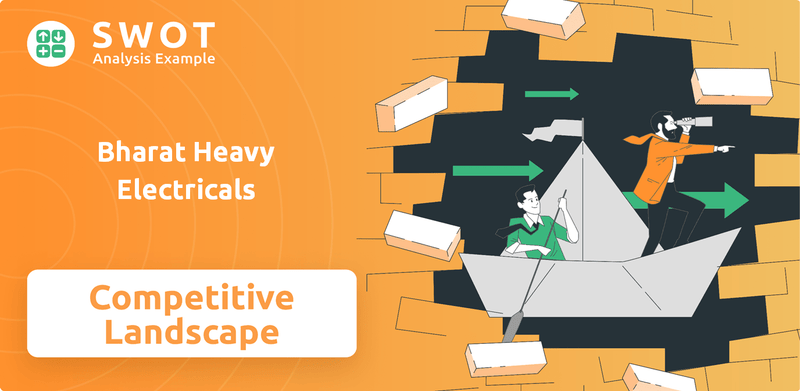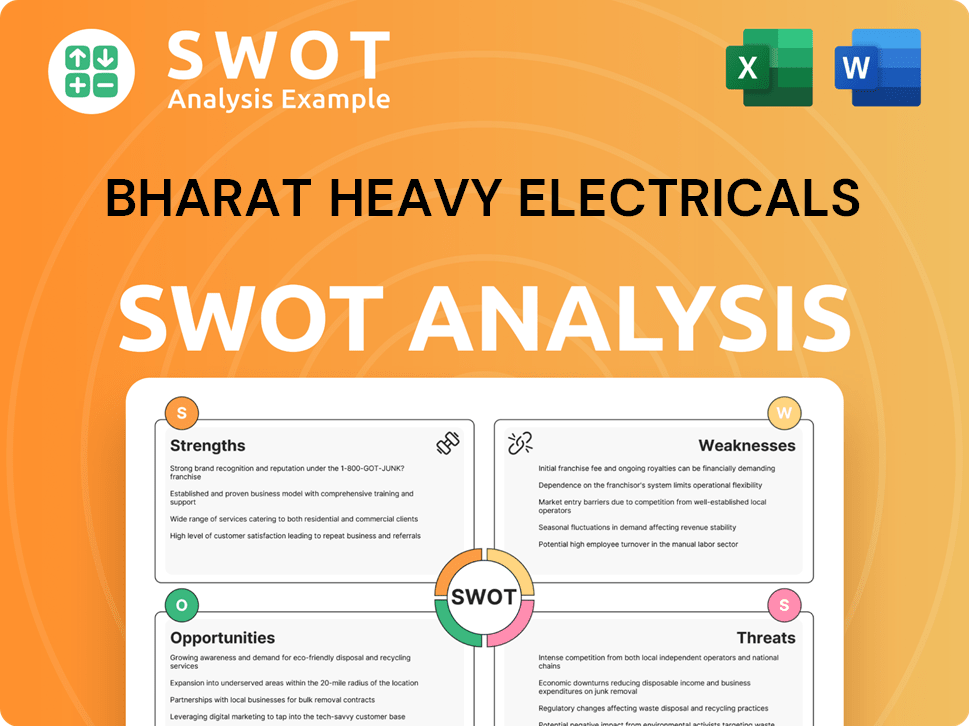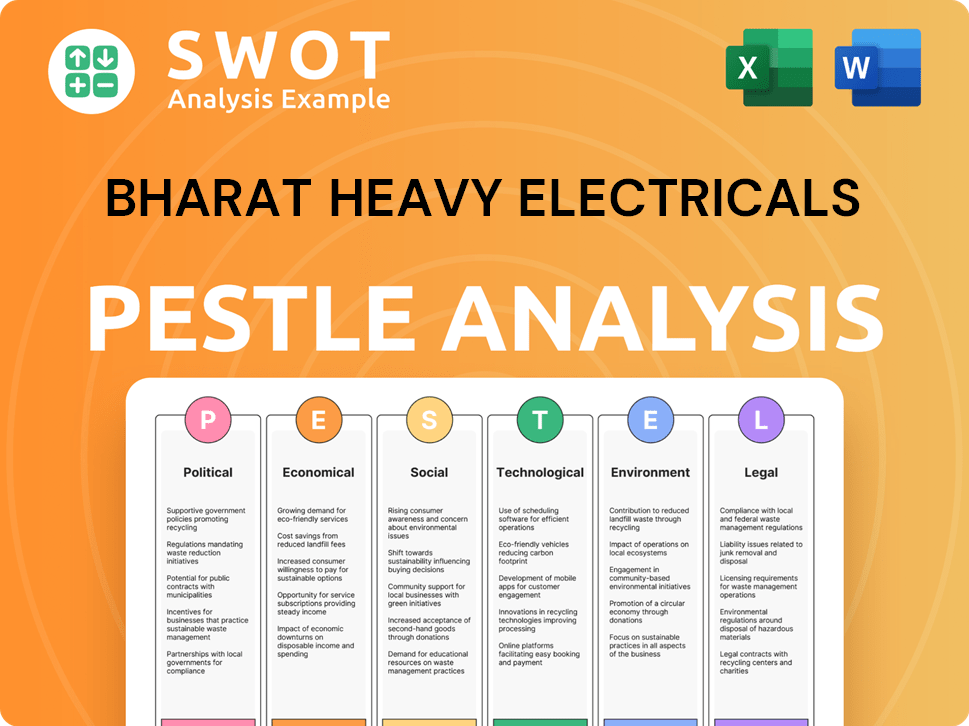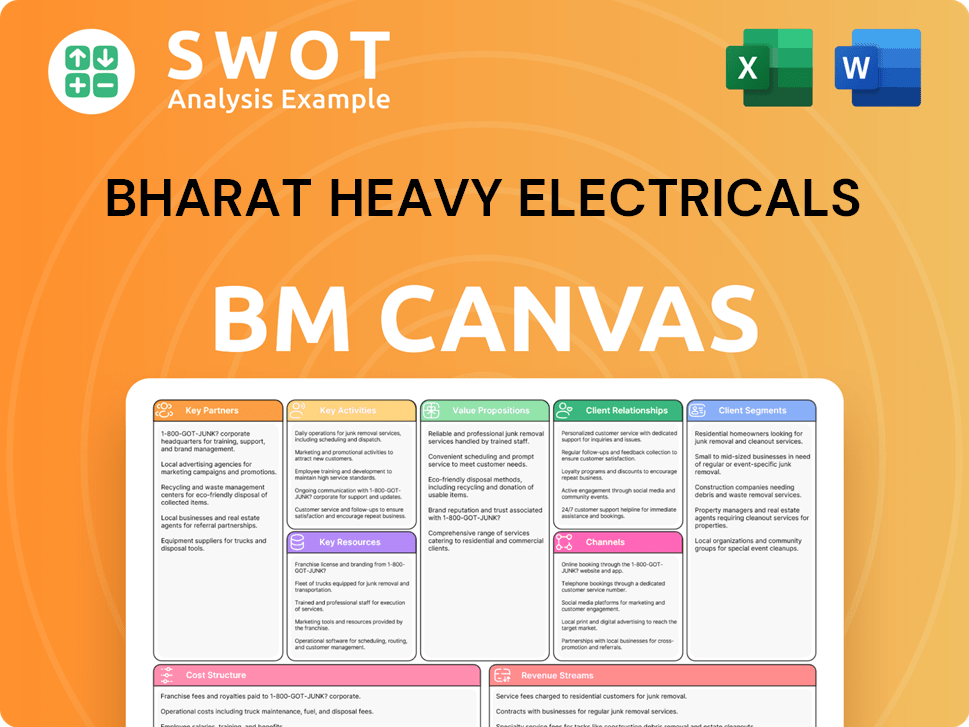Bharat Heavy Electricals Bundle
Can BHEL Maintain Its Dominance in India's Power Sector?
Bharat Heavy Electricals Limited (BHEL) has been a cornerstone of India's industrial growth since 1964, playing a pivotal role in the nation's infrastructure development. From its origins as a public sector undertaking, BHEL has evolved into a global player with a diverse portfolio spanning power generation, industry, and transportation. Understanding the Bharat Heavy Electricals SWOT Analysis is crucial for grasping its strategic position.

This analysis provides a deep dive into the Competitive Landscape of Bharat Heavy Electricals (BHEL), evaluating its position within the dynamic power sector. We'll examine BHEL's key industry rivals, assess its competitive advantages, and explore the challenges it faces in a rapidly changing market. A thorough market analysis is essential to understanding BHEL's strategies and future prospects, including its BHEL market share analysis and BHEL financial performance.
Where Does Bharat Heavy Electricals’ Stand in the Current Market?
Bharat Heavy Electricals Limited (BHEL) is a major player in India's heavy electrical equipment manufacturing sector, particularly within the power generation segment. The company's core operations involve the design, engineering, manufacturing, construction, testing, commissioning, and servicing of a wide range of products and services for the power, transmission, industry, transportation, renewable energy, oil & gas, and defense sectors. BHEL's value proposition lies in its comprehensive offerings, end-to-end solutions, and strong project execution capabilities, especially in large-scale infrastructure projects.
BHEL has a long-standing reputation and extensive experience in the power sector, with a significant presence in thermal power plants. The company has been instrumental in the development of India's power infrastructure, supplying equipment for various types of power plants. BHEL's commitment to quality, technological advancements, and customer service has helped it maintain a strong market position over the years. For additional context, you can explore the Brief History of Bharat Heavy Electricals.
BHEL's financial performance reflects its market position and operational efficiency. In FY24, BHEL reported a robust order inflow of Rs 39,267 crore, which is a 39% increase compared to the previous fiscal year. The company's profit after tax for FY24 was Rs 282 crore, demonstrating its financial resilience amidst competitive pressures.
BHEL holds a significant market share in the Indian power generation equipment sector, particularly in thermal power plants. While specific market share figures fluctuate, BHEL has consistently been a leading player.
BHEL's primary product lines include equipment for thermal, hydro, nuclear, and solar power plants. It also offers products for transmission, industry, transportation, renewable energy, oil & gas, and defense sectors.
BHEL serves a diverse customer base, including state and central power utilities, independent power producers, public and private sector industries, and international clients.
BHEL has a strong presence across India with manufacturing facilities and project sites. It has also expanded internationally, executing projects in over 83 countries across six continents.
BHEL's strengths include its strong legacy, extensive experience in large-scale infrastructure projects, and a diversified product portfolio. However, it faces intense competition in certain specialized or technologically advanced segments.
- Strong presence in the Indian power sector.
- Diversification into renewable energy and emission control systems.
- Exposure to cyclical demands in the power sector.
- Competition from both domestic and international players.
Bharat Heavy Electricals SWOT Analysis
- Complete SWOT Breakdown
- Fully Customizable
- Editable in Excel & Word
- Professional Formatting
- Investor-Ready Format

Who Are the Main Competitors Challenging Bharat Heavy Electricals?
Bharat Heavy Electricals Limited (BHEL) operates within a complex competitive environment, facing diverse rivals across its various business segments. The competitive landscape includes both global and domestic players, each vying for market share in sectors such as power generation, renewable energy, and industrial equipment. Understanding these competitors is crucial for assessing BHEL's market position and strategic challenges. A thorough market analysis reveals the strengths, weaknesses, and strategies of BHEL's key rivals, providing insights into the dynamics of the power sector and related industries.
The competitive dynamics are shaped by technological advancements, project execution capabilities, and financial strategies. BHEL's ability to maintain its market position depends on its capacity to innovate, adapt to changing market demands, and effectively compete with both established and emerging players. A detailed examination of the competitive landscape helps to understand the factors influencing BHEL's financial performance and its future outlook. For more information on the company's ownership structure, you can refer to Owners & Shareholders of Bharat Heavy Electricals.
In the thermal power sector, BHEL faces competition from global giants like Siemens Energy, GE Power, and Mitsubishi Heavy Industries. These companies often compete on the basis of advanced technology, global supply chains, and project financing capabilities. Domestically, Larsen & Toubro (L&T) is a significant competitor, particularly in engineering, procurement, and construction (EPC) for power projects. The renewable energy sector sees competition from companies like Adani Green Energy, ReNew Power, and Tata Power Solar, who specialize in solar and wind energy solutions.
Key global competitors include Siemens Energy, GE Power, and Mitsubishi Heavy Industries.
Larsen & Toubro (L&T) is a major domestic competitor, especially in EPC projects.
Adani Green Energy, ReNew Power, and Tata Power Solar are key competitors in renewable energy.
Competition is influenced by aggressive pricing, rapid deployment, and innovative financing.
Competition also arises from railway equipment manufacturers and electric vehicle infrastructure developers.
BHEL competes with specialized firms offering niche products and services.
The competitive landscape is influenced by mergers and acquisitions, technological advancements, and project execution capabilities.
- Technology: Competitors often differentiate through cutting-edge technology and efficiency.
- Project Execution: Strong project management and local presence are key advantages.
- Financing: Innovative financing models and aggressive pricing strategies impact market share.
- Market Trends: The shift towards renewable energy and electric mobility influences competition.
Bharat Heavy Electricals PESTLE Analysis
- Covers All 6 PESTLE Categories
- No Research Needed – Save Hours of Work
- Built by Experts, Trusted by Consultants
- Instant Download, Ready to Use
- 100% Editable, Fully Customizable

What Gives Bharat Heavy Electricals a Competitive Edge Over Its Rivals?
Bharat Heavy Electricals Limited (BHEL) holds a significant position in the Indian power sector and heavy electrical equipment industry. Understanding its competitive advantages is crucial for a comprehensive market analysis. BHEL's strengths have evolved over time, allowing it to maintain a strong presence in a dynamic market. This analysis will delve into the specific advantages that contribute to BHEL's competitive edge.
The company's competitive landscape is shaped by its ability to adapt to technological advancements and market demands. BHEL consistently invests in upgrading its manufacturing processes and product portfolio. This proactive approach ensures it remains competitive against both domestic and international rivals. BHEL's commitment to indigenous manufacturing also aligns with national initiatives like 'Make in India,' further solidifying its position in the domestic market.
BHEL's competitive advantages are multifaceted, encompassing manufacturing capabilities, engineering expertise, brand equity, and a strong service network. These factors collectively contribute to its ability to secure and execute large-scale projects. Analyzing these advantages provides insights into BHEL's strategic positioning and potential for future growth. For more information on their strategic approach, you can explore the Marketing Strategy of Bharat Heavy Electricals.
BHEL's extensive manufacturing infrastructure allows for in-house production of a wide range of components. This backward integration enhances cost efficiencies and ensures quality control. This capability is particularly beneficial for large, complex projects, providing a significant competitive advantage.
Decades of engineering expertise and strong R&D capabilities enable BHEL to develop and customize solutions. This includes advanced technologies for higher efficiency power plants and emission control systems. This focus on innovation allows BHEL to meet diverse client needs.
BHEL's long history of contributing to India's critical infrastructure has built strong brand equity. The company has established strong relationships with public sector undertakings and state utilities. This often makes BHEL a preferred partner for large-scale projects.
BHEL's extensive service network across India provides crucial post-sales support and maintenance. This fosters long-term client relationships. This network is essential for modernization services, ensuring continued operational efficiency for clients.
BHEL's competitive advantages are rooted in its robust manufacturing capabilities, engineering expertise, and strong brand reputation. These strengths enable BHEL to maintain a leading position in the power sector and heavy electrical equipment market. The company's focus on indigenous manufacturing further strengthens its position in the domestic market.
- Extensive manufacturing infrastructure and backward integration.
- Deep engineering expertise and strong R&D capabilities.
- Strong brand equity and customer loyalty, particularly with public sector clients.
- Extensive service network providing comprehensive post-sales support.
Bharat Heavy Electricals Business Model Canvas
- Complete 9-Block Business Model Canvas
- Effortlessly Communicate Your Business Strategy
- Investor-Ready BMC Format
- 100% Editable and Customizable
- Clear and Structured Layout

What Industry Trends Are Reshaping Bharat Heavy Electricals’s Competitive Landscape?
The heavy electrical equipment industry, where Bharat Heavy Electricals (BHEL) operates, is experiencing a period of significant transformation. The shift towards renewable energy and the need for decarbonization are reshaping the demand for power generation equipment. This creates both challenges and opportunities for BHEL, influencing its market position and future strategy. Understanding the competitive landscape is crucial for stakeholders.
BHEL's future outlook is closely tied to its ability to adapt to these changes. The company faces risks such as fluctuating raw material costs, geopolitical instability, and intense competition from both domestic and international players. However, there are also opportunities in the growing infrastructure development within India and the government's 'Make in India' initiatives. BHEL's strategic decisions regarding technology, partnerships, and diversification will determine its success.
The power sector is experiencing a global shift towards renewable energy sources, significantly impacting the demand for traditional coal-fired power plants. Regulatory changes, including stricter emission norms, are driving innovation in areas like carbon capture. Technological advancements such as digitalization and the integration of AI are also playing a crucial role.
BHEL faces challenges including decreasing demand for traditional power plants and the need for accelerated technological advancements in renewable energy. Intense competition from international players with advanced technologies and aggressive pricing strategies is a constant threat. Geopolitical factors and global supply chain disruptions also impact operations.
The Indian government's infrastructure development plans, including ambitious renewable energy targets, provide a strong domestic market. The 'Make in India' initiative favors domestic manufacturers like BHEL. Diversifying into emerging sectors such as green hydrogen and energy storage offers new avenues for growth.
BHEL must adapt its product portfolio and invest in cutting-edge technologies to stay competitive. Forming strategic alliances, both domestically and internationally, is crucial for technology transfer and market access. Focus on large-scale project execution and maintaining strong relationships with public sector clients is essential.
BHEL's success depends on its ability to navigate industry trends and capitalize on opportunities. The company's focus on renewable energy projects is increasing, with a growing order book in solar and hydro power. The company is also exploring new areas like green hydrogen and energy storage.
- Market Analysis: The Indian power sector is expected to grow, driven by increasing electricity demand and government initiatives.
- Competitive Advantages: BHEL has a strong presence in the Indian power sector and has a long history of executing large-scale projects.
- Future Outlook: The company's future depends on its ability to adapt and diversify its business. The Growth Strategy of Bharat Heavy Electricals will be critical.
- Financial Performance: BHEL's financial performance in recent years reflects the challenges and opportunities in the power sector.
Bharat Heavy Electricals Porter's Five Forces Analysis
- Covers All 5 Competitive Forces in Detail
- Structured for Consultants, Students, and Founders
- 100% Editable in Microsoft Word & Excel
- Instant Digital Download – Use Immediately
- Compatible with Mac & PC – Fully Unlocked

Related Blogs
- What are Mission Vision & Core Values of Bharat Heavy Electricals Company?
- What is Growth Strategy and Future Prospects of Bharat Heavy Electricals Company?
- How Does Bharat Heavy Electricals Company Work?
- What is Sales and Marketing Strategy of Bharat Heavy Electricals Company?
- What is Brief History of Bharat Heavy Electricals Company?
- Who Owns Bharat Heavy Electricals Company?
- What is Customer Demographics and Target Market of Bharat Heavy Electricals Company?
Disclaimer
All information, articles, and product details provided on this website are for general informational and educational purposes only. We do not claim any ownership over, nor do we intend to infringe upon, any trademarks, copyrights, logos, brand names, or other intellectual property mentioned or depicted on this site. Such intellectual property remains the property of its respective owners, and any references here are made solely for identification or informational purposes, without implying any affiliation, endorsement, or partnership.
We make no representations or warranties, express or implied, regarding the accuracy, completeness, or suitability of any content or products presented. Nothing on this website should be construed as legal, tax, investment, financial, medical, or other professional advice. In addition, no part of this site—including articles or product references—constitutes a solicitation, recommendation, endorsement, advertisement, or offer to buy or sell any securities, franchises, or other financial instruments, particularly in jurisdictions where such activity would be unlawful.
All content is of a general nature and may not address the specific circumstances of any individual or entity. It is not a substitute for professional advice or services. Any actions you take based on the information provided here are strictly at your own risk. You accept full responsibility for any decisions or outcomes arising from your use of this website and agree to release us from any liability in connection with your use of, or reliance upon, the content or products found herein.